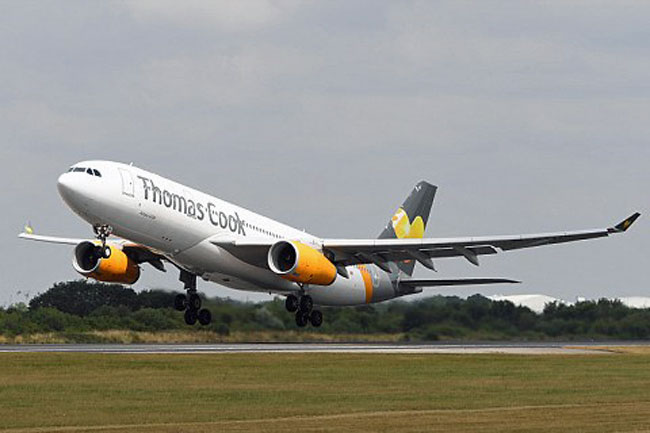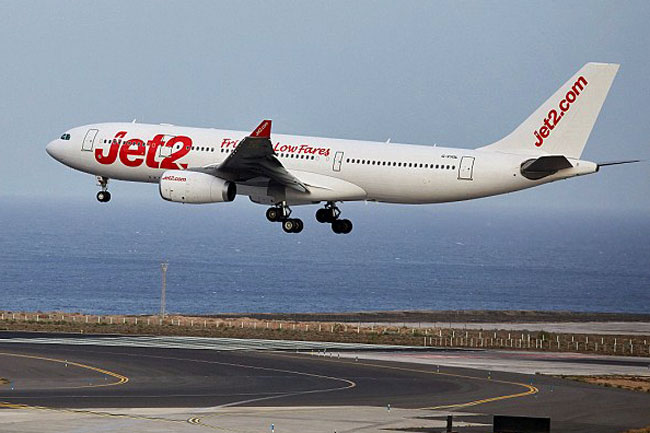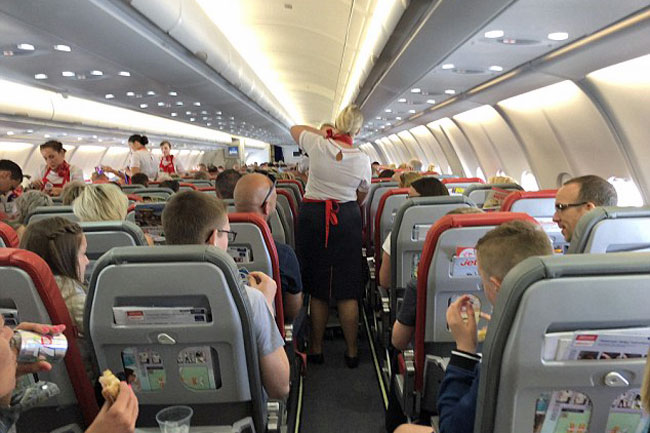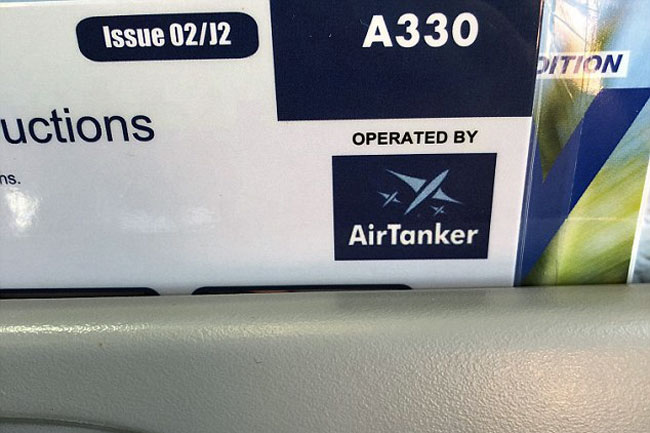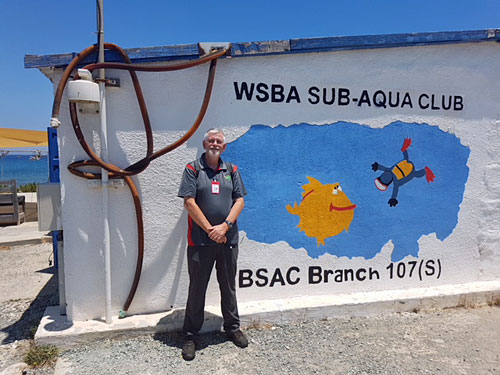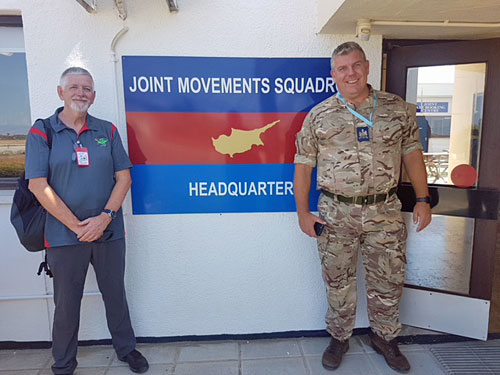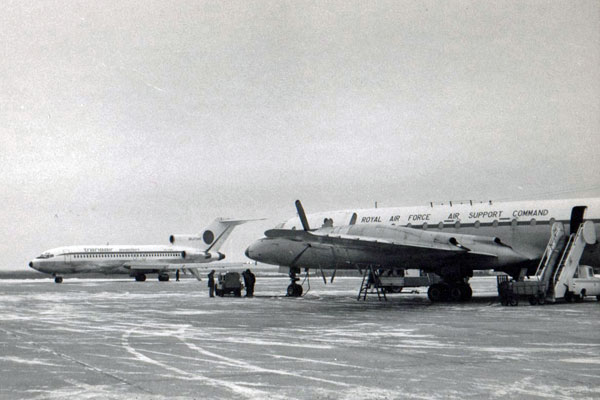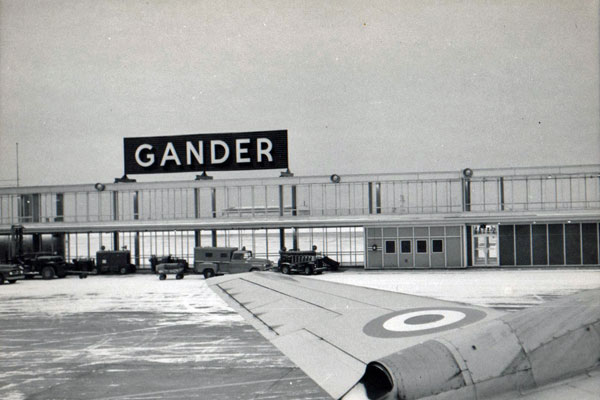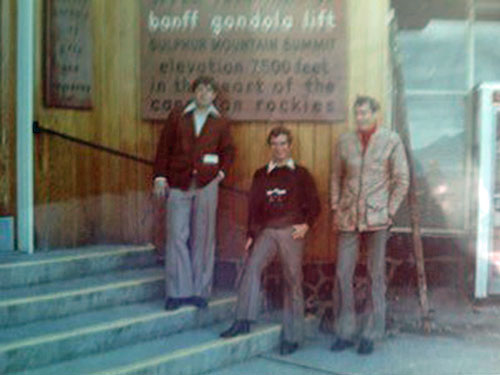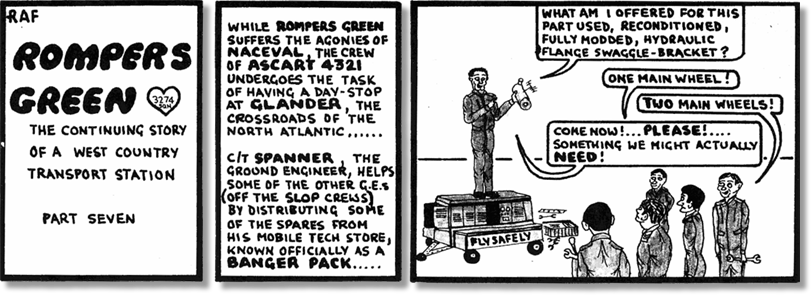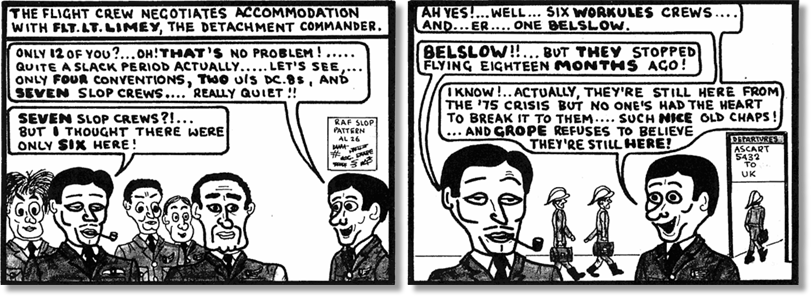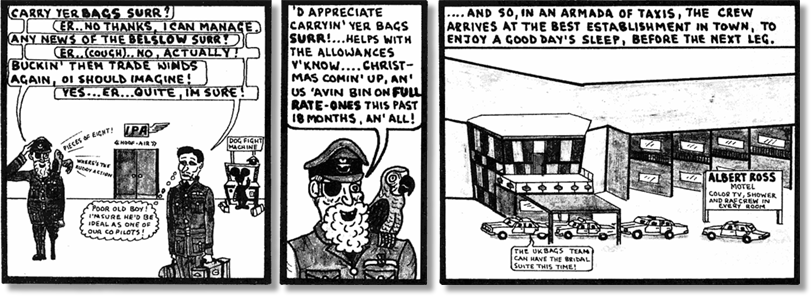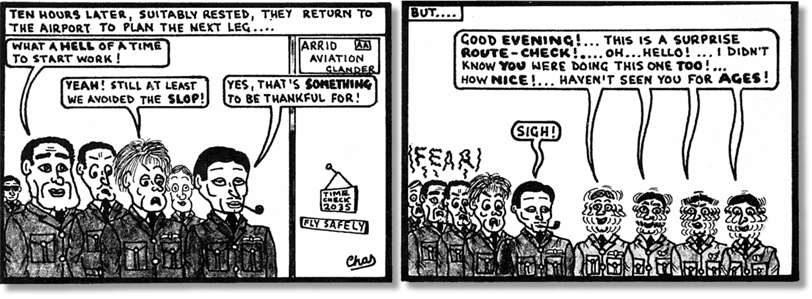


MoD blows £10.5 billion on military jets it doesn’t need which are used by Thomas Cook and Jet2 to fly tourists to the Med
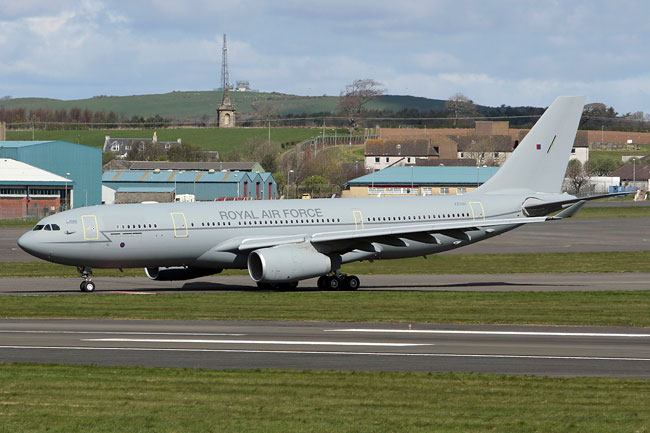
Three military jets – part of a fleet costing taxpayers an astonishing £10.5 billion – are being used to fly holidaymakers to sun-kissed resorts because the RAF has no use for them.
The aircraft are supposed to transport British troops to military bases around the world and refuel fighters and bombers in mid-air during combat sorties.
But a Mail on Sunday investigation can reveal that while the cash-strapped Ministry of Defence shells out tens of millions of pounds a year for the planes, holiday firms Thomas Cook and Jet2 have been using them to fly thousands of tourists to Majorca, Tenerife, New York and Florida.
The deal with a consortium of aviation manufacturers called AirTanker allows the commercial group to potentially make millions more by renting up to four of the unused aircraft to holiday firms.
Last week, The Mail on Sunday boarded one of the planes in Manchester and flew with hundreds of tourists on Jet2 package breaks to Tenerife. We also tracked two other RAF planes over the past week as they flew Thomas Cook holidaymakers from Manchester to New York, Seattle, Boston and Orlando.
MoD documents seen by The Mail on Sunday reveal that all three aircraft, which in their military role are called Voyager, remain part of the RAF’s fleet. It is understood they have never been used on operations, although the MoD refused to confirm this last night.
Read the full article here: The Mail on Sunday
In a direct response to the newspaper article, a Ministry of Defence spokesperson said: "Voyagers are playing a key role in protecting British airspace and the fight against Daesh, and whilst our core fleet is doing the job we need it to, we can call in the extra aircraft at short notice if we need them to help us defend the nation. When we’re not using them, it makes sense to have them performing other roles as that reduces our costs and means they can be ready for operations quicker than if they were held in storage. This is a cost-effective deal that is delivering an outstanding service for the RAF and has met all major project milestones on time and to budget."
The aircraft are supposed to transport British troops to military bases around the world and refuel fighters and bombers in mid-air during combat sorties.
But a Mail on Sunday investigation can reveal that while the cash-strapped Ministry of Defence shells out tens of millions of pounds a year for the planes, holiday firms Thomas Cook and Jet2 have been using them to fly thousands of tourists to Majorca, Tenerife, New York and Florida.
The deal with a consortium of aviation manufacturers called AirTanker allows the commercial group to potentially make millions more by renting up to four of the unused aircraft to holiday firms.
Last week, The Mail on Sunday boarded one of the planes in Manchester and flew with hundreds of tourists on Jet2 package breaks to Tenerife. We also tracked two other RAF planes over the past week as they flew Thomas Cook holidaymakers from Manchester to New York, Seattle, Boston and Orlando.
MoD documents seen by The Mail on Sunday reveal that all three aircraft, which in their military role are called Voyager, remain part of the RAF’s fleet. It is understood they have never been used on operations, although the MoD refused to confirm this last night.
Read the full article here: The Mail on Sunday
In a direct response to the newspaper article, a Ministry of Defence spokesperson said: "Voyagers are playing a key role in protecting British airspace and the fight against Daesh, and whilst our core fleet is doing the job we need it to, we can call in the extra aircraft at short notice if we need them to help us defend the nation. When we’re not using them, it makes sense to have them performing other roles as that reduces our costs and means they can be ready for operations quicker than if they were held in storage. This is a cost-effective deal that is delivering an outstanding service for the RAF and has met all major project milestones on time and to budget."
Back in January of this year, Andy Downard sent in the following request for help:
A question for the ‘brains trust’ amongst the membership! Maureen and I are planning a return to Cyprus 45 years after we met there in the mid 70’s. We have talked about trying to visit RAF Akrotiri, Air Movements and in particular the Scuba Dive Club where we spent a good deal of time above and below the water. So is this even possible and how might we go about organising this? Any suggestions and guidance most welcome.
A question for the ‘brains trust’ amongst the membership! Maureen and I are planning a return to Cyprus 45 years after we met there in the mid 70’s. We have talked about trying to visit RAF Akrotiri, Air Movements and in particular the Scuba Dive Club where we spent a good deal of time above and below the water. So is this even possible and how might we go about organising this? Any suggestions and guidance most welcome.
From: Kevin Skinner, Akrotiri
Subject: Andy Downard Visit To RAF Akrotiri
Greetings Tony,
Through the great work you do with the newsletter, I was put in contact with Andy Downard regarding facilitating a visit by him and his lovely wife to RAF Akrotiri. Andy and Maureen were stopping off in Cyprus on their way from their home near Melbourne to Scotland.
They met at RAF Akrotiri in the 70's when he was serving on the Air Movements Sqn and Maureen was working as a clerk in HQ NEAF at Episkopi, although she lived at Akrotiri and was bused to work daily! I believe he was here 75-78.
I gave Andy and Maureen a windscreen tour of the base and it was immediately evident to them that in some areas such as housing and barrack accommodation much had changed, although the female accommodation blocks are still standing and are currently used by Op SHADER FJ Sqn personnel. Members may recall the old camwood houses and blocks, these have all but disappeared and replaced with modern houses and barrack blocks.
Andy commented that much of the working site still remains the same, indeed during a tour of Air Cargo where he worked the pallet weighing and storage systems are still the same, and the old cargo office is still in the hangar although this is used by the Consignment Tracking Suppliers and the Movers have modern offices attached to the hangar.
Many Movers will remember the Air Cargo hangar and all I'd add is, there has been a lack of investment in many areas and Air Cargo is a prime example of this where Movers are using out dated and dangerous infrastructure, financial approval for a whole new cargo facility is currently sat at ministerial level so hopefully it will change soon.
Subject: Andy Downard Visit To RAF Akrotiri
Greetings Tony,
Through the great work you do with the newsletter, I was put in contact with Andy Downard regarding facilitating a visit by him and his lovely wife to RAF Akrotiri. Andy and Maureen were stopping off in Cyprus on their way from their home near Melbourne to Scotland.
They met at RAF Akrotiri in the 70's when he was serving on the Air Movements Sqn and Maureen was working as a clerk in HQ NEAF at Episkopi, although she lived at Akrotiri and was bused to work daily! I believe he was here 75-78.
I gave Andy and Maureen a windscreen tour of the base and it was immediately evident to them that in some areas such as housing and barrack accommodation much had changed, although the female accommodation blocks are still standing and are currently used by Op SHADER FJ Sqn personnel. Members may recall the old camwood houses and blocks, these have all but disappeared and replaced with modern houses and barrack blocks.
Andy commented that much of the working site still remains the same, indeed during a tour of Air Cargo where he worked the pallet weighing and storage systems are still the same, and the old cargo office is still in the hangar although this is used by the Consignment Tracking Suppliers and the Movers have modern offices attached to the hangar.
Many Movers will remember the Air Cargo hangar and all I'd add is, there has been a lack of investment in many areas and Air Cargo is a prime example of this where Movers are using out dated and dangerous infrastructure, financial approval for a whole new cargo facility is currently sat at ministerial level so hopefully it will change soon.
Following the windscreen tour I arranged for the current OIC of the Sub Aqua to meet with them both and show them around. Much of the club remains the same and Andy looked back fondly at his time as the clubs Training Officer, he and Maureen were also able to sit at the same bar where they had sat on their first date many years ago.
RAF Akrotiri now boasts an excellent Heritage Centre so Andy & Maureen were handed over to WO Neil Horan (Eng) one of the curators who showed them around the centre where they recalled much from their time here.
The visit included a trip up the Air Taffic Control tower and a tour of the Air Terminal, which although has been redesigned slightly is still functionally the same.
We finished the visit at the Joint Movements Sqn HQ, Air Movements became Joint Movements in 2001 when the RLC ATLO staff were subordinated under the SAMO.
RAF Akrotiri now boasts an excellent Heritage Centre so Andy & Maureen were handed over to WO Neil Horan (Eng) one of the curators who showed them around the centre where they recalled much from their time here.
The visit included a trip up the Air Taffic Control tower and a tour of the Air Terminal, which although has been redesigned slightly is still functionally the same.
We finished the visit at the Joint Movements Sqn HQ, Air Movements became Joint Movements in 2001 when the RLC ATLO staff were subordinated under the SAMO.
It was lovely to meet Andy and Maureen and hear of their time here, I think they enjoyed their visit. I've a attached a number of pictures and would add that if there are any other members who are visiting Cyprus and wish to come for a tour around the base I can arrange this as long as I have about a month's notice.
Thanks for the newsletter, keep up the good work.
Regards
Kev Skinner
WO JMS
RAF Akrotiri
Thanks for the newsletter, keep up the good work.
Regards
Kev Skinner
WO JMS
RAF Akrotiri
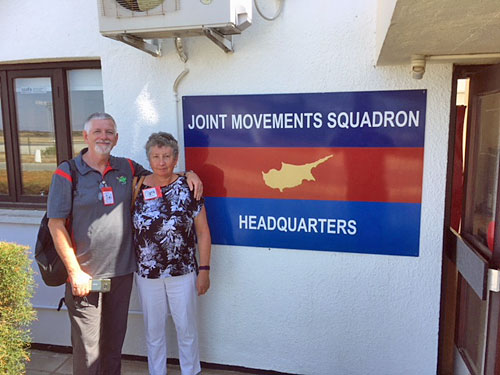

360° footage of Oz C-130J Hercules six-ship flyover of Sydney Harbour
To view a 360º video - On a desktop computer, you can either click and drag with a mouse or click the arrows in the upper left corner of the screen. On a mobile device, you can drag your finger across the screen or move it around in different directions.

From: Ronald Meredith, Spalding, Lincs
Subject: Memories of the USA
My first ever trip to the USA was in Sept 1958; flew outbound and return in a Comet 2 (XK 716, I think). From Cranwell, via Keflavic, Goose Bay, Trenton, HQ SAC, to Colorado Springs, returning via Andrews Field (Washington) and Goose Bay, then direct to Waddington.
As the only UT Equipper on the flight, I was given responsibility for preparing the trim sheet for each leg. Little did I think then, that throughout my service life (first with the RAF and then with the Terittorial Army), I would make a total of 18 visits to assorted locations in the USA and Canada. I have no particular movements related tales, but I was impressed with the RCAF load teams at Trenton and the USAF load teams at Albuquerque.
Must admit to one trip from Bentwaters to Andrews Field and back in a C141 Starlifter, in I think '92, that took most of my TA (RCT) unit to exercise with our US opposite numbers. It was a very interesting aircraft to fly in at that time.
Ron
Subject: Memories of the USA
My first ever trip to the USA was in Sept 1958; flew outbound and return in a Comet 2 (XK 716, I think). From Cranwell, via Keflavic, Goose Bay, Trenton, HQ SAC, to Colorado Springs, returning via Andrews Field (Washington) and Goose Bay, then direct to Waddington.
As the only UT Equipper on the flight, I was given responsibility for preparing the trim sheet for each leg. Little did I think then, that throughout my service life (first with the RAF and then with the Terittorial Army), I would make a total of 18 visits to assorted locations in the USA and Canada. I have no particular movements related tales, but I was impressed with the RCAF load teams at Trenton and the USAF load teams at Albuquerque.
Must admit to one trip from Bentwaters to Andrews Field and back in a C141 Starlifter, in I think '92, that took most of my TA (RCT) unit to exercise with our US opposite numbers. It was a very interesting aircraft to fly in at that time.
Ron

From: David Jarvis, Lunenburg, NS
Subject: Graduation
Hi Tony,
Just an update. Finished my studies and recently graduated as Valedictorian from the Akerley Campus of the Nova Scotia Community College, Boulanger and Baking Arts Program.
Now settled in beautiful Lunenburg, Nova Scotia. Just started my own business as a baker of gluten free goodies!
Regards,
Jarvo
https://www.facebook.com/TGIGFglutenfreebakery/
Subject: Graduation
Hi Tony,
Just an update. Finished my studies and recently graduated as Valedictorian from the Akerley Campus of the Nova Scotia Community College, Boulanger and Baking Arts Program.
Now settled in beautiful Lunenburg, Nova Scotia. Just started my own business as a baker of gluten free goodies!
Regards,
Jarvo
https://www.facebook.com/TGIGFglutenfreebakery/
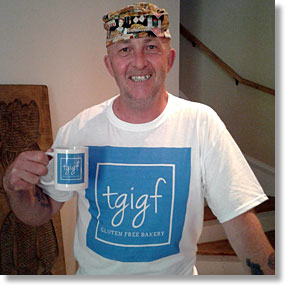






From: John Bell, Desborough, Northants
Subject: Memories of Canada
I was posted as a corporal from Mombasa to MAMS at RAF Abingdon in May 1965. Whilst on disembarkation leave I arranged for a married quarter and moved in. With still a couple of weeks leave left I called in at MAMS to introduce myself. The Ops staff told me I was going onto F Team and that my sergeant, Dan Archer, was in the crew room if I wanted to say hello. Sgt Archer was pleased to see me because he was a man light for an overseas task the next day and would I be prepared to come in early off my leave? Anxious to create a good impression I agreed. I was rushed through a task briefing and issued with a few bits of kit that afternoon and told I would be collected from my MQ the next morning. At this time I had not met any of the team other than Dan Archer and I had not had any training on mobile tasks. MAMS was a very relaxed organisation in 1965!
Next morning I was picked up and carted off to RAF Lyneham with my new team, led by Flying Officer John Dunn. On the Britannia I learned that the task was an “Exercise Pole Vault”. Also on the aircraft was the Royal Air Force Rugby Team, with their manager, an Air Commodore whose name I never knew. Landing at Gander several hours later we were all transported to the Gander Hotel for the night. This was when the fun started. Halfway through the night I awoke with a very sore throat. I had trouble breathing. I phoned the Reception and asked to speak to the MAMS Team Leader, meaning John Dunn. They put me through to the RUGBY team leader, the Air Commodore. I told him they had made a mistake and he asked me why I had phoned at 3 AM? I explained about my throat and he said he was a doctor and would come and see me straight away. A few minutes later he arrived and checked me out. He said I was going nowhere for several days and he phoned the local RCAF medical centre and arranged for me to be admitted. He said he would tell my Team Leader what had happened.
I was kept in the RCAF centre for 6 nights and returned to the Gander hotel the day before my team was due to return to the UK, transmitting through Gander. I went up to the airport to join the flight. In the departure/ transit lounge I met up again with my team. I was expecting a degree of sympathy from my teammates but this was not to be. Dan Archer took me to one side and delivered a mega rocket for not letting them know what was happening. I did explain but Dan was not best pleased. It turns out that the Air Commodore had not told my team leader of my situation until they were airborne. He had left the hotel early and come to see me at the medical centre and arrived at the airport at the last minute before take off. In the meantime my team had searched for me and were told by the hotel that I had checked out at 4 AM. These guys knew nothing about me, we had only met the day before. They assumed that I had done some sort of a runner! My name was mud and it took some weeks before I could establish any sort of credibility with my team.
I have done several dozen tasks to and through Canada since then but they have all been relatively incident free. Happy days!
Subject: Memories of Canada
I was posted as a corporal from Mombasa to MAMS at RAF Abingdon in May 1965. Whilst on disembarkation leave I arranged for a married quarter and moved in. With still a couple of weeks leave left I called in at MAMS to introduce myself. The Ops staff told me I was going onto F Team and that my sergeant, Dan Archer, was in the crew room if I wanted to say hello. Sgt Archer was pleased to see me because he was a man light for an overseas task the next day and would I be prepared to come in early off my leave? Anxious to create a good impression I agreed. I was rushed through a task briefing and issued with a few bits of kit that afternoon and told I would be collected from my MQ the next morning. At this time I had not met any of the team other than Dan Archer and I had not had any training on mobile tasks. MAMS was a very relaxed organisation in 1965!
Next morning I was picked up and carted off to RAF Lyneham with my new team, led by Flying Officer John Dunn. On the Britannia I learned that the task was an “Exercise Pole Vault”. Also on the aircraft was the Royal Air Force Rugby Team, with their manager, an Air Commodore whose name I never knew. Landing at Gander several hours later we were all transported to the Gander Hotel for the night. This was when the fun started. Halfway through the night I awoke with a very sore throat. I had trouble breathing. I phoned the Reception and asked to speak to the MAMS Team Leader, meaning John Dunn. They put me through to the RUGBY team leader, the Air Commodore. I told him they had made a mistake and he asked me why I had phoned at 3 AM? I explained about my throat and he said he was a doctor and would come and see me straight away. A few minutes later he arrived and checked me out. He said I was going nowhere for several days and he phoned the local RCAF medical centre and arranged for me to be admitted. He said he would tell my Team Leader what had happened.
I was kept in the RCAF centre for 6 nights and returned to the Gander hotel the day before my team was due to return to the UK, transmitting through Gander. I went up to the airport to join the flight. In the departure/ transit lounge I met up again with my team. I was expecting a degree of sympathy from my teammates but this was not to be. Dan Archer took me to one side and delivered a mega rocket for not letting them know what was happening. I did explain but Dan was not best pleased. It turns out that the Air Commodore had not told my team leader of my situation until they were airborne. He had left the hotel early and come to see me at the medical centre and arrived at the airport at the last minute before take off. In the meantime my team had searched for me and were told by the hotel that I had checked out at 4 AM. These guys knew nothing about me, we had only met the day before. They assumed that I had done some sort of a runner! My name was mud and it took some weeks before I could establish any sort of credibility with my team.
I have done several dozen tasks to and through Canada since then but they have all been relatively incident free. Happy days!
From: Mike Stepney, Stewarton, Ayrshire
Subject: Memories of Canada
I have been fortunate in having undertaken a number of Canadian tasks, both while at UKMAMS and on other RAF exercise deployments. However, this memory dump is more about the places than the UKMAMS tasks, so read-on if you will.
Gander, Newfoundland - Although only a transit stop, this has to have been the most military accommodating town in the Northern hemisphere. I have lost count of the number of times I have managed a night stop or two (depending on Albert’s serviceability) in Gander, and invariably there have been ‘Alberts’ or other military transports of other nations parked on the ramp. I have always departed Gander invariably with a sore head, but also with fond memories.
The bars, hotels and restaurants were clearly geared to transoceanic crews, with a great variety of drinks and menus on offer. I remember one bar/club in particular that was well frequented - The Flyers if my memory serves me. They had a drinks list high up behind the bar, with drinks very much in a military frame and titles like the B52, Aviator, Afterburner and the Kamikaze, and I seem to remember that I eventually managed to tick-off about 20 of the list during my many visits before I eventually ceased my transit stops.
One of the most unusual aspects of Gander was the number of Soviet passenger/cargo aircraft that could be found transiting through Gander. This being during the height of the cold war, it was quite strange to see the large Ilyushin IL-62 (VC10 ski), the Ilyushin IL-76 or the Antonov AN-12 parked on the ramp. The IL-62 had the support strut under the tail to stop it tipping when refuelling when empty of pax. The IL-62 was fitted with Solovyov D-30 turbofans which were much heavier than the RR Conway’s on the VC10’s. Story goes that the VC10 plans were ‘acquired’ by Soviet industrial spies, but they did not take into account that their engine technology at the time would force them to fit the much heavier power plants. See here: http://www.vc10.net/History/Comp_il62.html for some very good historical information on these two aircraft, though the author appears to indicate that the soviets did not copy the VC10 design, I digress, back to Canada!
Another strange element of Gander was the international arrivals area. There was a long corridor from the ramp to the arrivals lounge. Along the length of the corridor was a white strip painted on the floor, which clearly divided one half from the other; one was clearly defined as “International Area” the other as “Canadian Territory” – both signs were in English, French and Russian! I had noticed this strip a couple of times during previous transits and eventually asked one of the immigration officers why there was no formal barrier between the International and Canadian sides. This ‘open’ area I was advised was to allow free access to Canada and that when Soviet aircraft stopped for fuel on route to/from Havana, there were many passengers (scientists, engineers, chemists etc.) who either did not wish to go to Cuba, or return to the Soviet Union. This area allowed them to just step over the white line and seek asylum. On arrival and departure of the Soviet aircraft, armed Canadian Mounties manned the corridor and would quickly welcome anyone who stepped over the line. I understand that many did, and that despite Soviet complaints, the white line I believe remained until the end of the cold war in 1989.
Subject: Memories of Canada
I have been fortunate in having undertaken a number of Canadian tasks, both while at UKMAMS and on other RAF exercise deployments. However, this memory dump is more about the places than the UKMAMS tasks, so read-on if you will.
Gander, Newfoundland - Although only a transit stop, this has to have been the most military accommodating town in the Northern hemisphere. I have lost count of the number of times I have managed a night stop or two (depending on Albert’s serviceability) in Gander, and invariably there have been ‘Alberts’ or other military transports of other nations parked on the ramp. I have always departed Gander invariably with a sore head, but also with fond memories.
The bars, hotels and restaurants were clearly geared to transoceanic crews, with a great variety of drinks and menus on offer. I remember one bar/club in particular that was well frequented - The Flyers if my memory serves me. They had a drinks list high up behind the bar, with drinks very much in a military frame and titles like the B52, Aviator, Afterburner and the Kamikaze, and I seem to remember that I eventually managed to tick-off about 20 of the list during my many visits before I eventually ceased my transit stops.
One of the most unusual aspects of Gander was the number of Soviet passenger/cargo aircraft that could be found transiting through Gander. This being during the height of the cold war, it was quite strange to see the large Ilyushin IL-62 (VC10 ski), the Ilyushin IL-76 or the Antonov AN-12 parked on the ramp. The IL-62 had the support strut under the tail to stop it tipping when refuelling when empty of pax. The IL-62 was fitted with Solovyov D-30 turbofans which were much heavier than the RR Conway’s on the VC10’s. Story goes that the VC10 plans were ‘acquired’ by Soviet industrial spies, but they did not take into account that their engine technology at the time would force them to fit the much heavier power plants. See here: http://www.vc10.net/History/Comp_il62.html for some very good historical information on these two aircraft, though the author appears to indicate that the soviets did not copy the VC10 design, I digress, back to Canada!
Another strange element of Gander was the international arrivals area. There was a long corridor from the ramp to the arrivals lounge. Along the length of the corridor was a white strip painted on the floor, which clearly divided one half from the other; one was clearly defined as “International Area” the other as “Canadian Territory” – both signs were in English, French and Russian! I had noticed this strip a couple of times during previous transits and eventually asked one of the immigration officers why there was no formal barrier between the International and Canadian sides. This ‘open’ area I was advised was to allow free access to Canada and that when Soviet aircraft stopped for fuel on route to/from Havana, there were many passengers (scientists, engineers, chemists etc.) who either did not wish to go to Cuba, or return to the Soviet Union. This area allowed them to just step over the white line and seek asylum. On arrival and departure of the Soviet aircraft, armed Canadian Mounties manned the corridor and would quickly welcome anyone who stepped over the line. I understand that many did, and that despite Soviet complaints, the white line I believe remained until the end of the cold war in 1989.
Saint John, New Brunswick - (en route to McChord SEATAC, Washington State). Arrived early evening but it was already getting dark having driven into town from the airport. Why St John’s New Brunswick rather than the more usual stop-over of Gander or St John’s Newfoundland? No idea, though I think the Navigator was also puzzled! However, nice hotel, very lively bar and restaurant, up to the room around midnight and headed for bed. Looked out the window and there was a fabulous looking lake surrounded by the twinkle of lights from the town. Magic I thought might just get up a bit early and go for a jog (I was that way inclined in those days as a counter to sitting/napping for hours on end in Albert).
Alarm got me up at 06:00 and I opened the curtains only to discover that the lake that was outside the hotel at midnight was no longer there! I did a double take and sure enough, there was no lake, only a small waterfall in the distance and a narrow river running behind the hotel. Downstairs ready for my jog I happened on the night manager and asked him what they were putting in the drinks. I explained that I was positive that there had been a lake outside my window at midnight but there was only a river this morning. He said if I came back at midnight tonight, I would see the lake again! Saint John, New Brunswick, apparently has some of the world’s highest tides, and in this area the tides can be up to 16 meters (three story building height)! So high tide at midnight the lake (salt water of course), low tide at 06:00 the river, puzzle solved. Fascinating place where you don’t just tie your boat up, you attach it to a 60 foot line!
Goose Bay, Labrador - One of the coldest places I have visited in Canada. I was fortunate to visit a couple of times; once during the spring and once in November. The second trip was a 4 day information gathering visit I was given by Group in the mid 80’s, and I found the place fascinating. Each night I was there I witnessed the most vivid Arora Borealis. The colours, rather than the normal basic green we see from Scotland, were predominately bright red and purple with yellows and pinks and the almost pulsating light gave the impression that there should be accompanying sound. Each night I eventually had to head indoors or I would have suffered from frostbite. Even the Goose Bay staff I was working with commented that this was the best display they had seen.
Downtown Happy Valley was also an interesting place. I was sitting in a bar (having had a few) with my host, and was looking at a very vivid picture on the wall of the mountains, the forests, a river and float plane, very nice I thought. A little later another glance at the picture and the float plane had moved! This turned out to be a very large and crystal clear panoramic window. Maybe I had had sufficient Labbatt’s for that session, but nevertheless, I found Goose Bay interesting, and would not have minded a short tour there.
Many other destinations in Canada enjoyed on private trips including, Vancouver, Kamloops, Jasper, Calgary, on the scenic route to Yellowstone.
Mike Stepney
Alarm got me up at 06:00 and I opened the curtains only to discover that the lake that was outside the hotel at midnight was no longer there! I did a double take and sure enough, there was no lake, only a small waterfall in the distance and a narrow river running behind the hotel. Downstairs ready for my jog I happened on the night manager and asked him what they were putting in the drinks. I explained that I was positive that there had been a lake outside my window at midnight but there was only a river this morning. He said if I came back at midnight tonight, I would see the lake again! Saint John, New Brunswick, apparently has some of the world’s highest tides, and in this area the tides can be up to 16 meters (three story building height)! So high tide at midnight the lake (salt water of course), low tide at 06:00 the river, puzzle solved. Fascinating place where you don’t just tie your boat up, you attach it to a 60 foot line!
Goose Bay, Labrador - One of the coldest places I have visited in Canada. I was fortunate to visit a couple of times; once during the spring and once in November. The second trip was a 4 day information gathering visit I was given by Group in the mid 80’s, and I found the place fascinating. Each night I was there I witnessed the most vivid Arora Borealis. The colours, rather than the normal basic green we see from Scotland, were predominately bright red and purple with yellows and pinks and the almost pulsating light gave the impression that there should be accompanying sound. Each night I eventually had to head indoors or I would have suffered from frostbite. Even the Goose Bay staff I was working with commented that this was the best display they had seen.
Downtown Happy Valley was also an interesting place. I was sitting in a bar (having had a few) with my host, and was looking at a very vivid picture on the wall of the mountains, the forests, a river and float plane, very nice I thought. A little later another glance at the picture and the float plane had moved! This turned out to be a very large and crystal clear panoramic window. Maybe I had had sufficient Labbatt’s for that session, but nevertheless, I found Goose Bay interesting, and would not have minded a short tour there.
Many other destinations in Canada enjoyed on private trips including, Vancouver, Kamloops, Jasper, Calgary, on the scenic route to Yellowstone.
Mike Stepney
From: Andrew Spinks, Aylsham, Norfolk
Subject: CANADA
Although serving in the RAF rather than the Canadian Forces, I hugely enjoyed 3 years in Canada from 1979 to 1982. The first 2 years were with the RAF Movements Unit in Ottawa, working with our friends of 3 AMU at CFB Ottawa (South). The RAF Mov Unit’s main work was the transit twice a week of the Dulles VC10 schedule and all the VIPs it carried but there were sufficient other RAF and MOD PE visitors (and a few diversions) to keep us busy. Sadly for us, the MOD Moratorium in 1981 resulted in a decision to fly the VC10 non-stop to and from Dulles, and Canadian-bound or originating pax were to be sent civil air from and to Dulles. A visit shortly afterwards from the great Wg Cdr Vic King from 38 Group resulted in a ‘bad news/good news’ chat. The bad news was that I was being posted from Ottawa as there was no longer a need for an officer there. The good news was that I was re-posted to Calgary as the first permanent RAFLO at YYC (although that was of course bad news for UKMAMS team leaders who no longer had the regular Medicine Man tasks).
My particular memories are perhaps inevitably of things that went wrong. In Ottawa, this did not happen very often although we had an interesting episode when the Heads of Government met in Ottawa in 1980. We had to drive our service vehicle on the taxiways between the military and civil terminals most days to collect Canada Customs for our flights, and the flight Customs were meeting on this occasion was our PM’s VIP VC10. In all the time we had been driving on YOW we had used the callsign “Air Force One” to clear our taxiway transit with ATC. This had never been a problem until a more important user of this callsign (then a 707 but nowadays a blue 747) landed and was taxying. There was a little confusion before the nice folks in the Tower suggested over the airwaves that we should use another callsign and I think we were very swiftly allocated ‘Royal Air Force mobile’.
The second Ottawa moment was in the depths of a typical Ontario winter. MOD PE Boscombe Down used CFB Ottawa as its base for winter/icing trials on new aircraft, and their support aircraft was a Britannia. The Britannia and its one crew were actually regular visitors since they clearly enjoyed Ottawa either as a nightstop or for the service they received from us (hopefully both) and, since the aircrew knew us and treated us well, we did everything we could to help them. And so it was that we arranged to bed down the Britannia inside the one heated VIP hangar on a very cold winter’s night.
Subject: CANADA
Although serving in the RAF rather than the Canadian Forces, I hugely enjoyed 3 years in Canada from 1979 to 1982. The first 2 years were with the RAF Movements Unit in Ottawa, working with our friends of 3 AMU at CFB Ottawa (South). The RAF Mov Unit’s main work was the transit twice a week of the Dulles VC10 schedule and all the VIPs it carried but there were sufficient other RAF and MOD PE visitors (and a few diversions) to keep us busy. Sadly for us, the MOD Moratorium in 1981 resulted in a decision to fly the VC10 non-stop to and from Dulles, and Canadian-bound or originating pax were to be sent civil air from and to Dulles. A visit shortly afterwards from the great Wg Cdr Vic King from 38 Group resulted in a ‘bad news/good news’ chat. The bad news was that I was being posted from Ottawa as there was no longer a need for an officer there. The good news was that I was re-posted to Calgary as the first permanent RAFLO at YYC (although that was of course bad news for UKMAMS team leaders who no longer had the regular Medicine Man tasks).
My particular memories are perhaps inevitably of things that went wrong. In Ottawa, this did not happen very often although we had an interesting episode when the Heads of Government met in Ottawa in 1980. We had to drive our service vehicle on the taxiways between the military and civil terminals most days to collect Canada Customs for our flights, and the flight Customs were meeting on this occasion was our PM’s VIP VC10. In all the time we had been driving on YOW we had used the callsign “Air Force One” to clear our taxiway transit with ATC. This had never been a problem until a more important user of this callsign (then a 707 but nowadays a blue 747) landed and was taxying. There was a little confusion before the nice folks in the Tower suggested over the airwaves that we should use another callsign and I think we were very swiftly allocated ‘Royal Air Force mobile’.
The second Ottawa moment was in the depths of a typical Ontario winter. MOD PE Boscombe Down used CFB Ottawa as its base for winter/icing trials on new aircraft, and their support aircraft was a Britannia. The Britannia and its one crew were actually regular visitors since they clearly enjoyed Ottawa either as a nightstop or for the service they received from us (hopefully both) and, since the aircrew knew us and treated us well, we did everything we could to help them. And so it was that we arranged to bed down the Britannia inside the one heated VIP hangar on a very cold winter’s night.
Next morning it was being towed out for its departure to the US west coast when a severe snowstorm suddenly erupted. The warm skin of the aircraft melted the heavy snow until the skin quite quickly got cold... and colder... and colder, and the melted snow then froze over the whole aircraft. It was much more than the de-icers could cope with and our gesture of support in giving them a nice warm aircraft for the departure went spectacularly wrong. Fortunately, also because the crew knew us so well and appreciated what we had aimed to do, they did not blame the movers.
(What a change from some of the AT crews at home base in UK who sadly would often unfairly blame the movers when an aircraft was delayed because.... “Movements were still on the aircraft when we should have been off chocks”. Never mind that the aircraft was 2 hours late off tech deadline and we only had one hour to load a full freighter VC10. Whoops, a bit of old baggage surfacing there.)
The last episode worthy of note was at Calgary’s fairly new terminal (it was still fairly new in 1980). The Medicine Man VC10s usually got one of the ‘fingers’ at the Terminal as they were normally on a QTR with a slip crew. 10 Sqn got used to this and it seems the inbound crew just assumed on one occasion, contrary to instructions from the Air Canada ground communications team, that they would park on the usual ‘finger’. Put it down to crew fatigue after a long flight or whatever, but this was a night-stopping VC10 and had to park on a remote stand. Rustling up a tug and tow bar in double quick time to clear the finger before the allocated Air Canada flight taxied in resulted in some very sharp exchanges between the flight deck crew and myself. Actually the co-pilot was and still is a good friend and we laughed about it afterwards but it was no joke at the time.
What an amazing and splendid country Canada is. I spent 3 very happy years there and I remember 3 AMU and the Air Canada team at YYC with great affection. Three lines from different verses of the Canadian national anthem sum it up for me...
(What a change from some of the AT crews at home base in UK who sadly would often unfairly blame the movers when an aircraft was delayed because.... “Movements were still on the aircraft when we should have been off chocks”. Never mind that the aircraft was 2 hours late off tech deadline and we only had one hour to load a full freighter VC10. Whoops, a bit of old baggage surfacing there.)
The last episode worthy of note was at Calgary’s fairly new terminal (it was still fairly new in 1980). The Medicine Man VC10s usually got one of the ‘fingers’ at the Terminal as they were normally on a QTR with a slip crew. 10 Sqn got used to this and it seems the inbound crew just assumed on one occasion, contrary to instructions from the Air Canada ground communications team, that they would park on the usual ‘finger’. Put it down to crew fatigue after a long flight or whatever, but this was a night-stopping VC10 and had to park on a remote stand. Rustling up a tug and tow bar in double quick time to clear the finger before the allocated Air Canada flight taxied in resulted in some very sharp exchanges between the flight deck crew and myself. Actually the co-pilot was and still is a good friend and we laughed about it afterwards but it was no joke at the time.
What an amazing and splendid country Canada is. I spent 3 very happy years there and I remember 3 AMU and the Air Canada team at YYC with great affection. Three lines from different verses of the Canadian national anthem sum it up for me...
O Canada!
Our home and native land!
God keep our land glorious and free!
Our home and native land!
God keep our land glorious and free!
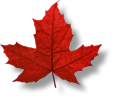
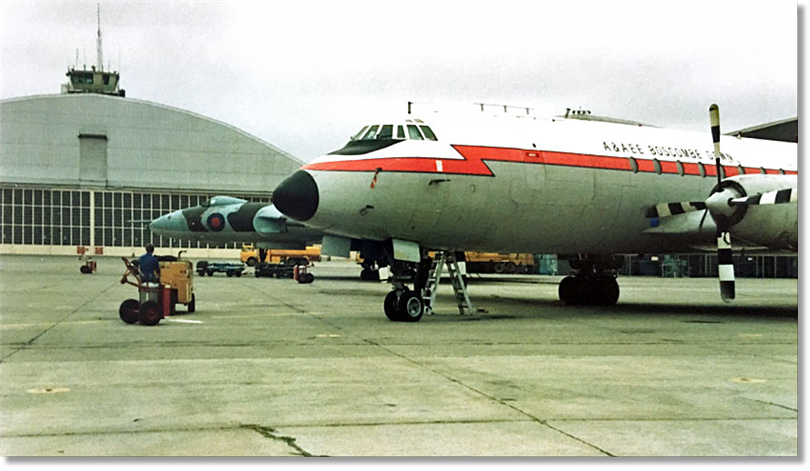
The Boscombe Down Britannia and a visiting Vulcan, possibly on a Boscombe Down trial
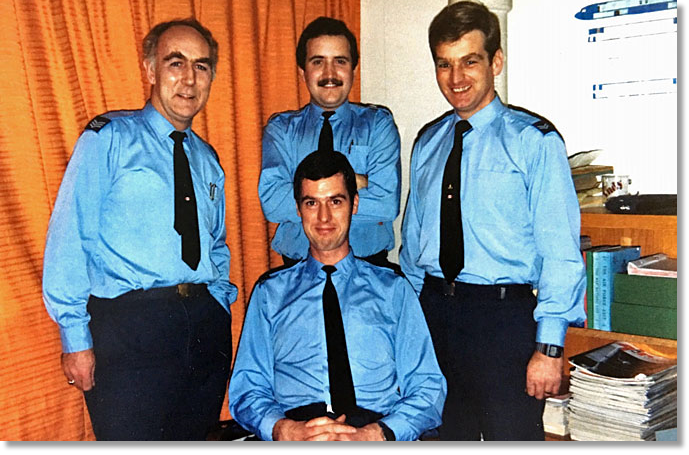
I am the one seated and behind me are Sgt Geoff Beare (who handed over later to Colin Allen), SAC Mal Palfrey, and Cpl George Templeton (who later handed over to Clive Bishop).
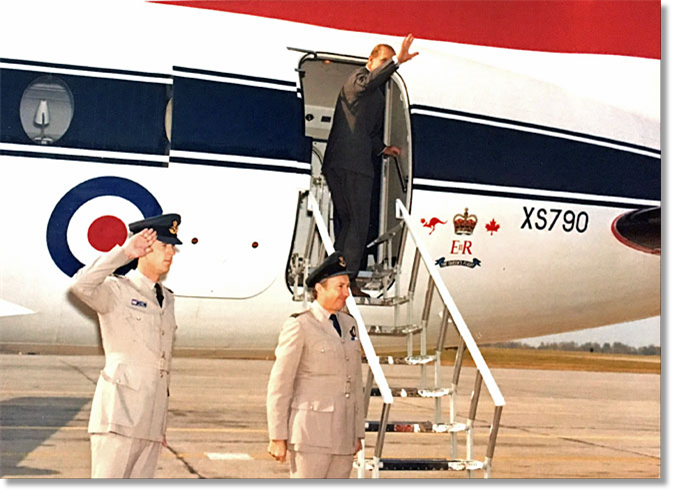
HRH Prince Philip boards an Andover of The Queen’s Flight
From: David Powell, Princes Risborough, Bucks
Subject: Memories of Canada
During my all too short time on UKMAMS, F Team did several Belfast and Britannia trips either through Gander to the USA or terminating in mainland Canada.
Subject: Memories of Canada
During my all too short time on UKMAMS, F Team did several Belfast and Britannia trips either through Gander to the USA or terminating in mainland Canada.
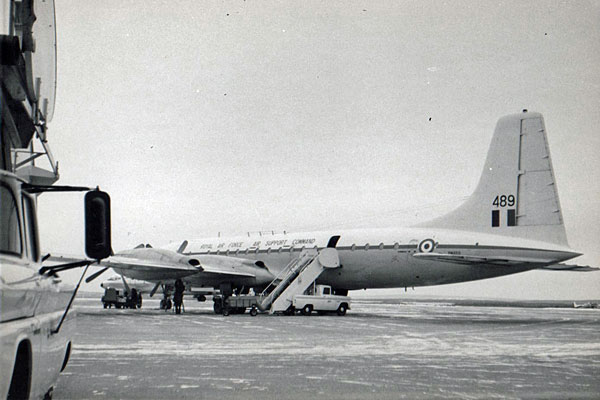
Memories of Gander are: bleak, cold (see photos), fantastic post-flight steak meals at the airport (my first encounter with Thousand Island Dressing!), Flyers Club, being stuck because of weather and or serviceability, and Flyers Club. I am guessing from the log book that the photos were taken in December 1967 on the way to Offutt, McClellan and Hickam (Hawaii) where Clive Price reminded us recently of the incident involving a post card and a flapped trash can. Thank you Clive, greatly appreciated! This run was 2-7 Dec 1967, with Brit 489, skipper Wg Cdr Yetman OC 99 Sqn.
Of the latter destinations, there were two particularly memorable runs. The first, 7-15 Jan 1968 with Brit 658, skipper Flt Lt Warren, was to Cold Lake, Alberta, with missiles (Fire Streak?) for cold weather trials. I can still remember vividly stepping out onto the aircraft steps fully kitted out in Arctic Parkas, Gloves etc. and the that incredible initial impact of ice cold stillness. It felt as though, if you shouted out loud, you and your whole world would turn into a solid block of ice. I think it was minus 24º F.
The other trip was probably F Team’s finest. This was with a Belfast, loading at Boscombe Down, via Gander to Ottawa which comprised not just two Wessex (one facing forward and one aft) with their respective blade boxes and separated rotor hub/gearboxes but also: a Wasp helicopter on the ramp; all the necessary rollers and dunnage for the off-load; 3 triples on the ramp (2 with end seats folded flat to fit under the Wasp) to provide the 7 seats for the team and the aircraft’s ground engineer, and the usual Belfast route aircraft spares and handling pack-up. The layout was such that as intended the tail of the rear-facing angled Wasp dropped into the space between the two Wessex as the ramp was closed.
The adventure started (almost) well when on arrival at Boscombe, the Wessex were found to be on cradles for surface movement. No metal end-skids to ease the load over the rollers, critical for the transition from level to the sloping ramp. Without the skids the square ended cradle beams would dig into the rollers. Solution, initiate MAMS Team Improvisation Test. This resulted in the ‘discovery’ of two FLAT pieces of 18 inch square steel plate in the corner of a hangar. Now this was at around 7.00 pm so we were left to our own devices.
Of the latter destinations, there were two particularly memorable runs. The first, 7-15 Jan 1968 with Brit 658, skipper Flt Lt Warren, was to Cold Lake, Alberta, with missiles (Fire Streak?) for cold weather trials. I can still remember vividly stepping out onto the aircraft steps fully kitted out in Arctic Parkas, Gloves etc. and the that incredible initial impact of ice cold stillness. It felt as though, if you shouted out loud, you and your whole world would turn into a solid block of ice. I think it was minus 24º F.
The other trip was probably F Team’s finest. This was with a Belfast, loading at Boscombe Down, via Gander to Ottawa which comprised not just two Wessex (one facing forward and one aft) with their respective blade boxes and separated rotor hub/gearboxes but also: a Wasp helicopter on the ramp; all the necessary rollers and dunnage for the off-load; 3 triples on the ramp (2 with end seats folded flat to fit under the Wasp) to provide the 7 seats for the team and the aircraft’s ground engineer, and the usual Belfast route aircraft spares and handling pack-up. The layout was such that as intended the tail of the rear-facing angled Wasp dropped into the space between the two Wessex as the ramp was closed.
The adventure started (almost) well when on arrival at Boscombe, the Wessex were found to be on cradles for surface movement. No metal end-skids to ease the load over the rollers, critical for the transition from level to the sloping ramp. Without the skids the square ended cradle beams would dig into the rollers. Solution, initiate MAMS Team Improvisation Test. This resulted in the ‘discovery’ of two FLAT pieces of 18 inch square steel plate in the corner of a hangar. Now this was at around 7.00 pm so we were left to our own devices.
These included the world’s greatest fixer – the then Corporal Bob Turner! Bob’s highly sophisticated technical solution was to wedge in turn each of the plates upright in the hangar door tracking, and then drive over them with a 12,000lb fork lift. This converted two flat plates into two curved plates which could be slipped under the ends of the cradle as it approached the pair of inclined rollers and job done!The spectacular Canadian memory was the offload. As old hands will remember, for the Wessex/Belfast task this involved building slopes with dunnage (assorted thick wooden planks) connecting the end of the lowered aircraft ramp and ground level. The dunnage was overlaid with roller and in this instance the important Turner Plates were positioned under the cradle timbers ahead of the change of angle as the roller departed from ground level.
To appreciate how this particularly memorable offload went, I need to set the scene. It was night; it was winter; it was cold; it was windy; it had been snowing; the concrete ground was covered with a film of ice and snow; within a very short time even the roller (pre-cooled in flight) was iced, and the noise of ground power units was lit by eerie orange lighting. And by the way, the offload area was on a port to starboard slope. This meant that each Wessex attempted to slide off sideways as they were winched down the rollers while the timber dunnage was noisily compressing into the snow/ice surface. This required continuous improvised adjustment to the timber packing during the offload. However, the team and Turner plates prevailed and job done!
The final memory of that trip was from when we eventually checked into our night stop hotel. Not only was beer needed but more trouble beckoned! This was when I discovered through a very public humiliation from the bar staff (I thought that the Mounties were going to be summoned) that having sipped one’s ale at the bar while debriefing the skipper, in no way was one permitted to carry their half-full glass to a table to join one’s colleagues. This counted as table-service which in this Province was a closed-shop profession for professional waiters only!
Interestingly, it was to be 50 years before I returned to Canada. And, that was just two weeks ago! Yesterday, Sue and I got back from a SKIing (Spending Kids Inheritance) bucket list adventure: BA A380 Heathrow to Vancouver; met and shown round this lovely city by Martin Christy a colleague I had trained with at Cranwell; an inside passage Alaska cruise up to the Hubbard Glaciers via Sitka and back through Juneau and Kamchatka; more of Vancouver (including discovering a miniature railway in Stanley Park); then two days Gold Leaf on the Rocky Mountaineer (rightly claiming to be one of the best train journeys in the world), and finishing up with 3 days in majestic mountain surrounded Banff, including seeing 3 alternating sections of a two mile freight train as it threaded its way climbing through the Kicking Horse Pass double spirals, before flying back (BA B787-8 Dreamliner) direct from Calgary in under 8 hours!
Best wishes to you all, stay safe.
David Powell
F Team UKMAMS 1967-69
PS. So sad to learn of the passing of fellow Abingdon Team Leader, David Stevens, only a year older than myself, ouch! He was movements operational until very recently as a Red Cross responder called upon at the outset of a crisis involving humanitarian aid, to set up and run the critical supply chain from the emergency relief airhead or port to where it was needed.
PPS. Looking at the photo of a bleak and empty 1960s Gander makes an interesting contrast with today’s airports as arriving and departing aircraft tip toe through an ever increasing clutter of lights, direction boards, ground equipment, safety equipment and vehicles!
To appreciate how this particularly memorable offload went, I need to set the scene. It was night; it was winter; it was cold; it was windy; it had been snowing; the concrete ground was covered with a film of ice and snow; within a very short time even the roller (pre-cooled in flight) was iced, and the noise of ground power units was lit by eerie orange lighting. And by the way, the offload area was on a port to starboard slope. This meant that each Wessex attempted to slide off sideways as they were winched down the rollers while the timber dunnage was noisily compressing into the snow/ice surface. This required continuous improvised adjustment to the timber packing during the offload. However, the team and Turner plates prevailed and job done!
The final memory of that trip was from when we eventually checked into our night stop hotel. Not only was beer needed but more trouble beckoned! This was when I discovered through a very public humiliation from the bar staff (I thought that the Mounties were going to be summoned) that having sipped one’s ale at the bar while debriefing the skipper, in no way was one permitted to carry their half-full glass to a table to join one’s colleagues. This counted as table-service which in this Province was a closed-shop profession for professional waiters only!
Interestingly, it was to be 50 years before I returned to Canada. And, that was just two weeks ago! Yesterday, Sue and I got back from a SKIing (Spending Kids Inheritance) bucket list adventure: BA A380 Heathrow to Vancouver; met and shown round this lovely city by Martin Christy a colleague I had trained with at Cranwell; an inside passage Alaska cruise up to the Hubbard Glaciers via Sitka and back through Juneau and Kamchatka; more of Vancouver (including discovering a miniature railway in Stanley Park); then two days Gold Leaf on the Rocky Mountaineer (rightly claiming to be one of the best train journeys in the world), and finishing up with 3 days in majestic mountain surrounded Banff, including seeing 3 alternating sections of a two mile freight train as it threaded its way climbing through the Kicking Horse Pass double spirals, before flying back (BA B787-8 Dreamliner) direct from Calgary in under 8 hours!
Best wishes to you all, stay safe.
David Powell
F Team UKMAMS 1967-69
PS. So sad to learn of the passing of fellow Abingdon Team Leader, David Stevens, only a year older than myself, ouch! He was movements operational until very recently as a Red Cross responder called upon at the outset of a crisis involving humanitarian aid, to set up and run the critical supply chain from the emergency relief airhead or port to where it was needed.
PPS. Looking at the photo of a bleak and empty 1960s Gander makes an interesting contrast with today’s airports as arriving and departing aircraft tip toe through an ever increasing clutter of lights, direction boards, ground equipment, safety equipment and vehicles!

From: Clive Price, Brecon
Subject: Canada memories
Loved the country, starting with Gander on a transatlantic night stop. Even in winter, an after-flight meal at the hotel and then converting the official evening meal into beer. I always had a large salmon steak.
On one trip to Toronto for the big air show we had nothing more than a ground power trolley to deliver on a Britannia. Toronto was so full we had to find somewhere else to park. The captain elected to go to, of all places, San Francisco. We stayed in a lovely hotel, and as a bonus it was the Labour Day Weekend. Had a great time seeing all the sights; riding the cable cars and looking across the bay at Alcatraz. We returned to Toronto on the Monday.
Wasn't mobile a hard life?
Taff Price,
UKMAMS (1966-70)
Subject: Canada memories
Loved the country, starting with Gander on a transatlantic night stop. Even in winter, an after-flight meal at the hotel and then converting the official evening meal into beer. I always had a large salmon steak.
On one trip to Toronto for the big air show we had nothing more than a ground power trolley to deliver on a Britannia. Toronto was so full we had to find somewhere else to park. The captain elected to go to, of all places, San Francisco. We stayed in a lovely hotel, and as a bonus it was the Labour Day Weekend. Had a great time seeing all the sights; riding the cable cars and looking across the bay at Alcatraz. We returned to Toronto on the Monday.
Wasn't mobile a hard life?
Taff Price,
UKMAMS (1966-70)

From: Kevin Koslowski-Smith, Cambridge
Subject: Memories of Canada
Tony,
I don't have much to say about Canada... I did my one and only UKMAMS trip back in the early 90's, during the first Gulf War, on a VC10 to Norfolk, Virginia, dropping off the Royal Marines band to play on the HMY Britannia. Keith Parker was the Flight Sergeant, myself as Corporal and Geordie Gash as moral support. I won't go into the small and incredibly silly incidents that happened during our stay in the USA...
On the way there though, we stopped off at Gander to drop off some freight. The snow had fallen so hard that the wing-tips seemed to touch the crusty top of the ice-cold snow drifts, caused, no doubt by clearing the runway. Nuff' said, it was icily cold, we had to hand-ball the freight out of the rear hold and I caught my finger on the banding wire wrapped around one of the crates. I wiped my face with my bare hand and most of my 90's 'moustache broke off! We got back in the VC10 once all the freight had been collected, to continue our merry way to the USA. The aircraft soon warmed up, whereupon my finger started to leak profusely with the claret coloured stuff; I hadn't even noticed I had cut the thing as it had been THAT cold. Masses of blue paper towel and an understanding trolley dolly soon mended the hurt!
All the best
Kev Koslowski-Smith
Subject: Memories of Canada
Tony,
I don't have much to say about Canada... I did my one and only UKMAMS trip back in the early 90's, during the first Gulf War, on a VC10 to Norfolk, Virginia, dropping off the Royal Marines band to play on the HMY Britannia. Keith Parker was the Flight Sergeant, myself as Corporal and Geordie Gash as moral support. I won't go into the small and incredibly silly incidents that happened during our stay in the USA...
On the way there though, we stopped off at Gander to drop off some freight. The snow had fallen so hard that the wing-tips seemed to touch the crusty top of the ice-cold snow drifts, caused, no doubt by clearing the runway. Nuff' said, it was icily cold, we had to hand-ball the freight out of the rear hold and I caught my finger on the banding wire wrapped around one of the crates. I wiped my face with my bare hand and most of my 90's 'moustache broke off! We got back in the VC10 once all the freight had been collected, to continue our merry way to the USA. The aircraft soon warmed up, whereupon my finger started to leak profusely with the claret coloured stuff; I hadn't even noticed I had cut the thing as it had been THAT cold. Masses of blue paper towel and an understanding trolley dolly soon mended the hurt!
All the best
Kev Koslowski-Smith

From: David Taylor, York
Subject: Memories of Canada
Two trips to Canada are probably worth a mention. The first was Exercise Brightwater, I believe. Goose Bay was well astern, our Britannia now lined up for a landing at the Canadian Air Force base of Churchill, Manitoba, when a situation occurred.
It was foggy and cold outside. Very foggy, extremely cold. Minus twenty-two degrees centigrade, to be precise; cold enough to spread major concern amongst the male brass monkey population. Difficult conditions, then. Instrument Flight Rules prevailed, naturally. And although approach aids had now advanced to the basic Instrument Landing System stage, radar and a talk-down (GCA approach) still played a part. In other words, it could be hazardous. Though in this respect service flights were generally much safer than their civilian counterparts. Service pilots took less chances, for the cost of diverting a service aircraft was borne by the taxpayer, didn’t detract from the profits, as it were.
In this instance our first approach was a miss. Overshoot procedure: full power, flaps one third, gear up. Oh, oh, small problem: still three greens. The landing gear stubbornly refused to retract. Much better than the reverse, of course, but still a problem. Now what? Divert, with the gear down, or go round again? Much better to try again, it seemed, for round we went. A wide circuit, long, straight approach, concentration intense, one imagines. With nothing to be seen outside, attention would be focussed on the instruments and, in the headset; the disembodied voice of a distant controller.
But not for us, back in the cabin. That our rearward facing seats gave us a view of where we had been rather than where we were headed mattered not one iota at present, fog looks the same when viewed from any direction. We had only what our imagination allowed us, and faith in the crew. Just as the crew needed to have faith in that controller, their training, and in what the instruments were telling them.
Down and down we went, as if gingerly feeling the way, which, in effect, we were. It was always reassuring to catch a glimpse of any odd light that came into view, more so if they happened to be the approach lights, as on this occasion.
We floated above the glistening surface, then, a slight bump, the rumble of rotating wheels, and we were down, worry replaced by relief. Suddenly the air smelt sweeter, the cabin felt warmer, more familiar. And once we were out on the tarmac, nostril hairs frozen solid, we discovered the answer to the problem. Particles of freezing fog formed a solid sheet of ice on the forward surfaces of the undercarriage struts. It was inches thick, smooth and translucent, effectively welding the gear in place. Strong stuff, this ice.
A difficult place in which to work then, Churchill, due to the extreme cold. In fact, once the wind speed reached a certain level, all external doors on the camp were automatically locked. Taking into account the wind chill factor, it was deemed far too dangerous for anyone to venture out, and as all buildings were interconnected, via heated walkways, there was really no need.
My next visit was another VIP trip, this time with Chief of the Defence Staff, Earl Mountbatten, so we needed to position at London Heathrow for the pick-up. After which it was then fairly routine - as far as our line of work went that is! A day in Toronto, two days in Ottawa, and a day in Montreal, Quebec, before crossing the border for the USA, with days at Andrews AFB, Washington, Norfolk, Virginia, and Jacksonville, Florida, and back to Heathrow. I guess if you are CDS you can set up a tour to wherever your fancy takes you!
Subject: Memories of Canada
Two trips to Canada are probably worth a mention. The first was Exercise Brightwater, I believe. Goose Bay was well astern, our Britannia now lined up for a landing at the Canadian Air Force base of Churchill, Manitoba, when a situation occurred.
It was foggy and cold outside. Very foggy, extremely cold. Minus twenty-two degrees centigrade, to be precise; cold enough to spread major concern amongst the male brass monkey population. Difficult conditions, then. Instrument Flight Rules prevailed, naturally. And although approach aids had now advanced to the basic Instrument Landing System stage, radar and a talk-down (GCA approach) still played a part. In other words, it could be hazardous. Though in this respect service flights were generally much safer than their civilian counterparts. Service pilots took less chances, for the cost of diverting a service aircraft was borne by the taxpayer, didn’t detract from the profits, as it were.
In this instance our first approach was a miss. Overshoot procedure: full power, flaps one third, gear up. Oh, oh, small problem: still three greens. The landing gear stubbornly refused to retract. Much better than the reverse, of course, but still a problem. Now what? Divert, with the gear down, or go round again? Much better to try again, it seemed, for round we went. A wide circuit, long, straight approach, concentration intense, one imagines. With nothing to be seen outside, attention would be focussed on the instruments and, in the headset; the disembodied voice of a distant controller.
But not for us, back in the cabin. That our rearward facing seats gave us a view of where we had been rather than where we were headed mattered not one iota at present, fog looks the same when viewed from any direction. We had only what our imagination allowed us, and faith in the crew. Just as the crew needed to have faith in that controller, their training, and in what the instruments were telling them.
Down and down we went, as if gingerly feeling the way, which, in effect, we were. It was always reassuring to catch a glimpse of any odd light that came into view, more so if they happened to be the approach lights, as on this occasion.
We floated above the glistening surface, then, a slight bump, the rumble of rotating wheels, and we were down, worry replaced by relief. Suddenly the air smelt sweeter, the cabin felt warmer, more familiar. And once we were out on the tarmac, nostril hairs frozen solid, we discovered the answer to the problem. Particles of freezing fog formed a solid sheet of ice on the forward surfaces of the undercarriage struts. It was inches thick, smooth and translucent, effectively welding the gear in place. Strong stuff, this ice.
A difficult place in which to work then, Churchill, due to the extreme cold. In fact, once the wind speed reached a certain level, all external doors on the camp were automatically locked. Taking into account the wind chill factor, it was deemed far too dangerous for anyone to venture out, and as all buildings were interconnected, via heated walkways, there was really no need.
My next visit was another VIP trip, this time with Chief of the Defence Staff, Earl Mountbatten, so we needed to position at London Heathrow for the pick-up. After which it was then fairly routine - as far as our line of work went that is! A day in Toronto, two days in Ottawa, and a day in Montreal, Quebec, before crossing the border for the USA, with days at Andrews AFB, Washington, Norfolk, Virginia, and Jacksonville, Florida, and back to Heathrow. I guess if you are CDS you can set up a tour to wherever your fancy takes you!

From: Alan Potts, 11100 Narbonne
Subject: Memories of Canada
The Army spent so much time in Canada that I guess most movers have done a stint in Calgary. Certainly I had one such trip with Romeo team in ’76, mainly pax and baggage handling of the troops flying in from Germany on the VC10. I think everyone enjoyed the Calgary task, good hotac, good restaurants and good downtime between flights. If memory serves me right the hotel was The Pallisades, very comfy and well located and our team used to enjoy the home cooked food at Mother Tucker’s, a clear favourite. On a bad weather day or waiting for a flight it would be cards in the hotel or if we had more time it was exploring the city and going up the Tower. The one thing that made the task tiring was the flight arrival/departure times; inevitably with the VC10 routing, Brize-Gutersloh-Gander-Calgary delays occurred and we often got out of bed at 2 or 3 in the morning. Still the delays served us well as the recovery a/c went u/s at Gut for an engine change and gave us 2 days off.
Subject: Memories of Canada
The Army spent so much time in Canada that I guess most movers have done a stint in Calgary. Certainly I had one such trip with Romeo team in ’76, mainly pax and baggage handling of the troops flying in from Germany on the VC10. I think everyone enjoyed the Calgary task, good hotac, good restaurants and good downtime between flights. If memory serves me right the hotel was The Pallisades, very comfy and well located and our team used to enjoy the home cooked food at Mother Tucker’s, a clear favourite. On a bad weather day or waiting for a flight it would be cards in the hotel or if we had more time it was exploring the city and going up the Tower. The one thing that made the task tiring was the flight arrival/departure times; inevitably with the VC10 routing, Brize-Gutersloh-Gander-Calgary delays occurred and we often got out of bed at 2 or 3 in the morning. Still the delays served us well as the recovery a/c went u/s at Gut for an engine change and gave us 2 days off.
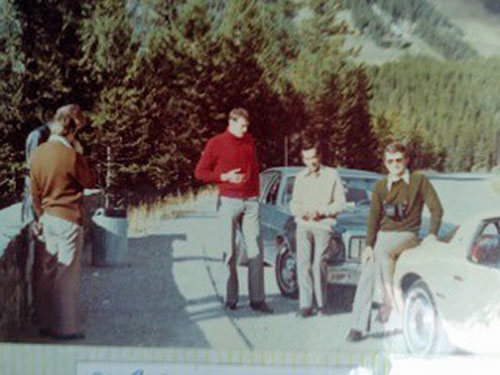
The then Flying Officer "Tricky Dickie" Leonard hired 2 cars and off we went to Banff and the surrounding area, naturally the boss chose a Pontiac Firebird 2-seater sports car for him and one other, and a saloon for the remainder. Happy days, and of course, as a team, we transited Gander on many occasions to pick up a sore head after too many drinks!
I also managed 2 extra days in Vancouver due to a delay; unfortunately we caused the delay and the C130 skipper was not amused!! There were 3 of us, myself, Speedy Soane and Dick Bullimore and the task involved taking a ships propeller for a damaged RFA vessel.
The propeller was palletised and when we off loaded someone undid one of the tensioners before we rolled the pallet out; as the pallet went down the roller the tensioner swung out from the pallet and hit the direct vision inspection window in the wheel well. Naturally it cracked! Once serviceable again Upavon tasked the crew home with minimal ground time. A lovely place to be stranded for a couple of days.
Many years later in my Hong Kong incarnation I managed a trip to Edmonton with 2 B747-400s chartered from Cathay Pacific. It was1996 I think and the Army units stationed in Germany were unable to fill one of the MEDMAN slots so the HQBFHK staffs grabbed it for the Gurkhas. The aircraft were handled in Edmonton by the Calgary det, augmented by a team from, where else, UKMAMS. I had a great couple of days catching up with old friends and, thanks to Andy Machell, I had the best hotac etc, etc.
Many thanks to all my old Romeo team mates and all the other great guys who made my time on UKMAMS so enjoyable.
Team in the pictures (sorry for the quality, they're old): Dick Leonard, Ivan Vienneau, myself, Dick Bullimore and Stretch Weir (hidden).
I also managed 2 extra days in Vancouver due to a delay; unfortunately we caused the delay and the C130 skipper was not amused!! There were 3 of us, myself, Speedy Soane and Dick Bullimore and the task involved taking a ships propeller for a damaged RFA vessel.
The propeller was palletised and when we off loaded someone undid one of the tensioners before we rolled the pallet out; as the pallet went down the roller the tensioner swung out from the pallet and hit the direct vision inspection window in the wheel well. Naturally it cracked! Once serviceable again Upavon tasked the crew home with minimal ground time. A lovely place to be stranded for a couple of days.
Many years later in my Hong Kong incarnation I managed a trip to Edmonton with 2 B747-400s chartered from Cathay Pacific. It was1996 I think and the Army units stationed in Germany were unable to fill one of the MEDMAN slots so the HQBFHK staffs grabbed it for the Gurkhas. The aircraft were handled in Edmonton by the Calgary det, augmented by a team from, where else, UKMAMS. I had a great couple of days catching up with old friends and, thanks to Andy Machell, I had the best hotac etc, etc.
Many thanks to all my old Romeo team mates and all the other great guys who made my time on UKMAMS so enjoyable.
Team in the pictures (sorry for the quality, they're old): Dick Leonard, Ivan Vienneau, myself, Dick Bullimore and Stretch Weir (hidden).

From: Dougie Russell, Carlisle, Cumbria
Subject: Memories of Canada
Hi Tony,
I can’t remember exact dates or team members, but left Brize at 1700 Friday on a TriStar K1 - landed Edmonton - bags etc., off and on - hotel - food - bed - get up - West Edmonton Mall for 4½ hours - back to hotel, change, check-out - airport - finish loading - depart - land Brize Sunday at 1700 - back to work on Monday morning. That was fun!
Subject: Memories of Canada
Hi Tony,
I can’t remember exact dates or team members, but left Brize at 1700 Friday on a TriStar K1 - landed Edmonton - bags etc., off and on - hotel - food - bed - get up - West Edmonton Mall for 4½ hours - back to hotel, change, check-out - airport - finish loading - depart - land Brize Sunday at 1700 - back to work on Monday morning. That was fun!

Here, hold my beer...
LM-100J Super Hercules Goes Inverted at Farnborough 2018
LM-100J Super Hercules Goes Inverted at Farnborough 2018
Lockheed Martin's LM-100J Super Hercules flight demonstration from the Farnborough International Air Show 2018 literally stole the show when Chief Pilot Wayne Robert pulled off maneuvers which literally made the Super Hercules mimic a Tom Cat out of "Top Gun". You see "Old pilots" or you end up seeing "Bold Pilots", but rarely you come across an "Old and Bold" pilot like Wayne Robert. Captain Wayne Robert's behind the wheel was apparently pulling off his last air show display before retiring, so he clearly seems to be taking all the leverage he needed to pull off stunts which would make people forget "fighters" at Farnborough.

More Relevant Stuff
From: Mick Goater, Goole, West Yorkshire
Subject: Charity Ride
Tony,
I will be doing a cycle ride for Cure Leukaemia. For some stupid reason during the last football season, I said if Wolverhampton got promoted to the Premier League, I would cycle to the first game (before you ask, I was sober at the time).
So, for this great charity, on the 4th August, at 62 years young, over 5 Days I will cycle 150 miles to raise money for Cure Leukaemia.
The Goole To Wolverhamton route details are on my just giving page: https://www.justgiving.com/fundraising/michael-goater3
I know we sadly lost Andy Robicheau recently to this disease, so I am sure some out there may be willing to give to my ride.
While what I am doing is only a small thing compared to many others' efforts, I still hope to rasie awareness and money for this good cause.
Regards,
Mick
Subject: Charity Ride
Tony,
I will be doing a cycle ride for Cure Leukaemia. For some stupid reason during the last football season, I said if Wolverhampton got promoted to the Premier League, I would cycle to the first game (before you ask, I was sober at the time).
So, for this great charity, on the 4th August, at 62 years young, over 5 Days I will cycle 150 miles to raise money for Cure Leukaemia.
The Goole To Wolverhamton route details are on my just giving page: https://www.justgiving.com/fundraising/michael-goater3
I know we sadly lost Andy Robicheau recently to this disease, so I am sure some out there may be willing to give to my ride.
While what I am doing is only a small thing compared to many others' efforts, I still hope to rasie awareness and money for this good cause.
Regards,
Mick
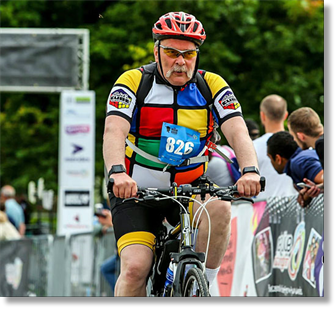

CANADIAN ARMED FORCES · WEDNESDAY, JULY 25, 2018
As of October 17, 2018, the Government of Canada will legalize and regulate cannabis. We know you have questions about what this means for you.
We are committed to fostering a safe and healthy workplace for all members of the Defence Team, and ensuring that the Canadian military remains a fit, deployable, and effective force. We are developing guidance for the Defence Team as the use of cannabis could impact the operational effectiveness and safety of our members. That guidance will be made available before the new law takes effect this fall.
A policy specific to the Canadian Armed Forces (CAF) will provide direction to members on restrictions based on duty, safety, and operational effectiveness and will outline the consequences of misuse. Direction will also be provided to civilian public servants, contractors, and employees of external organizations who work on DND properties to ensure safe and impairment-free work environments.
Impairment continues to be strictly prohibited in all federal workplaces and defence establishments, including impairment as a result of alcohol, opioids, cannabis or any other legal or illegal drug.
Until the new legislation comes into force on October 17, cannabis remains illegal and National Defence will continue to apply existing laws and policies for recreational and medical use.
We will continue to share information with you about the implementation of the new legislation as it becomes available.
General Jonathan Vance
Chief of the Defence Staff
Jody Thomas
Deputy Minister of National Defence
As of October 17, 2018, the Government of Canada will legalize and regulate cannabis. We know you have questions about what this means for you.
We are committed to fostering a safe and healthy workplace for all members of the Defence Team, and ensuring that the Canadian military remains a fit, deployable, and effective force. We are developing guidance for the Defence Team as the use of cannabis could impact the operational effectiveness and safety of our members. That guidance will be made available before the new law takes effect this fall.
A policy specific to the Canadian Armed Forces (CAF) will provide direction to members on restrictions based on duty, safety, and operational effectiveness and will outline the consequences of misuse. Direction will also be provided to civilian public servants, contractors, and employees of external organizations who work on DND properties to ensure safe and impairment-free work environments.
Impairment continues to be strictly prohibited in all federal workplaces and defence establishments, including impairment as a result of alcohol, opioids, cannabis or any other legal or illegal drug.
Until the new legislation comes into force on October 17, cannabis remains illegal and National Defence will continue to apply existing laws and policies for recreational and medical use.
We will continue to share information with you about the implementation of the new legislation as it becomes available.
General Jonathan Vance
Chief of the Defence Staff
Jody Thomas
Deputy Minister of National Defence
CDS / DM Message for all members of the Defence Team:
Legalization and Regulation of Cannabis
Legalization and Regulation of Cannabis
From: Grant Carey
Subject: Guest Book Entry
My father was Reg Carey. I am especially looking for information on anyone who served with him in Aden around 1961.
Grant Carey
Subject: Guest Book Entry
My father was Reg Carey. I am especially looking for information on anyone who served with him in Aden around 1961.
Grant Carey
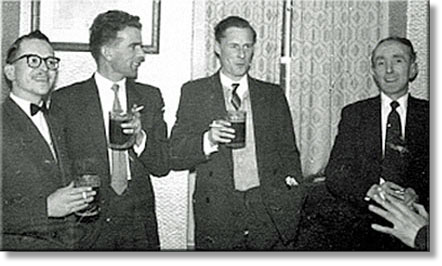
Reg Carey, John Guerin, Jimmie Durkin and Joe Marmion
If you wish to respond to Grant, click on the flags next to his name above
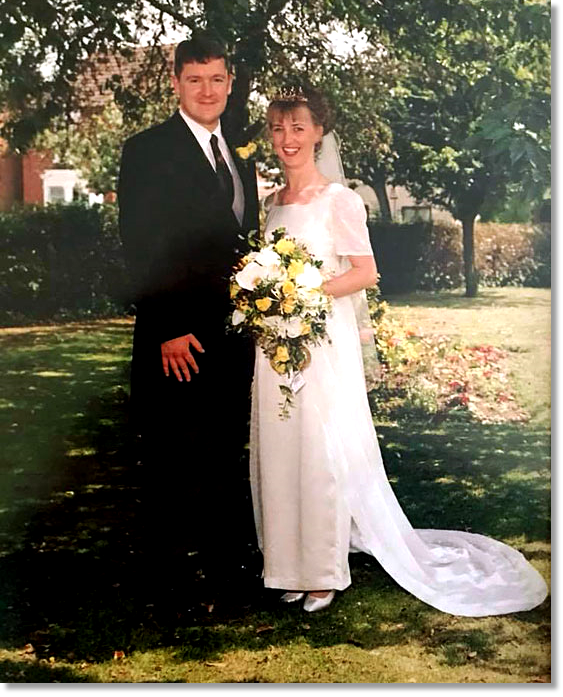
Phil and Emma Overson (RAF) celebrated their 19th Anniversary on July 10th
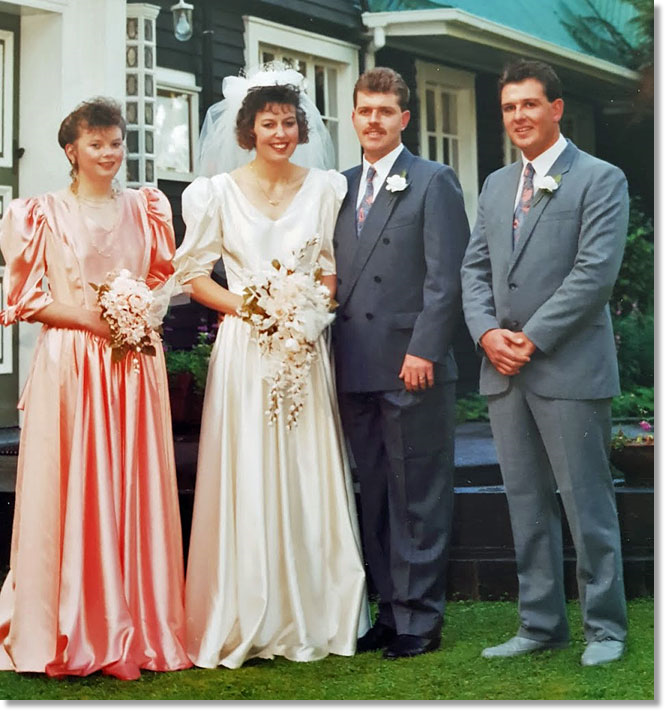
Brian and Charmaine Lay (RNZAF) 19th July, 1991
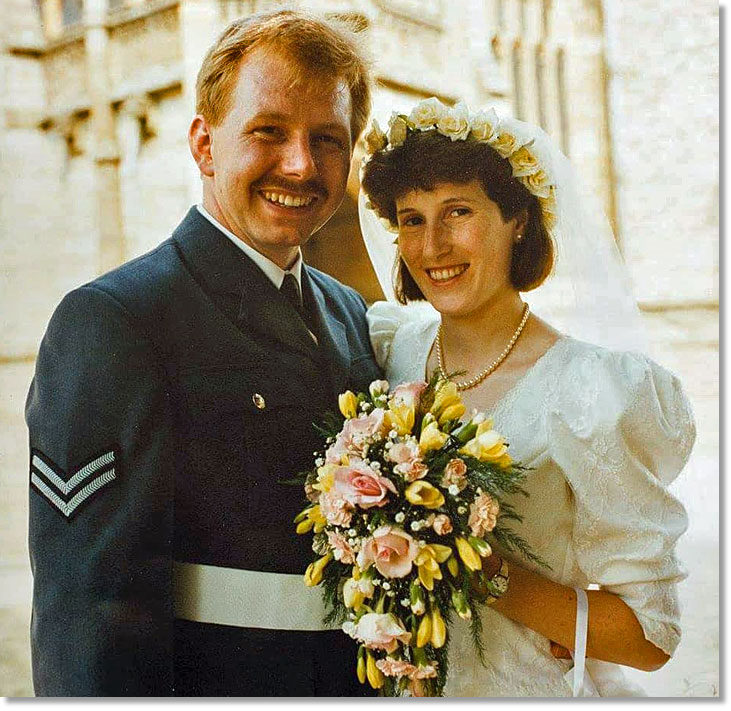
John and Rachel Belcher (RAF) celebrated their 28th on the 21st July
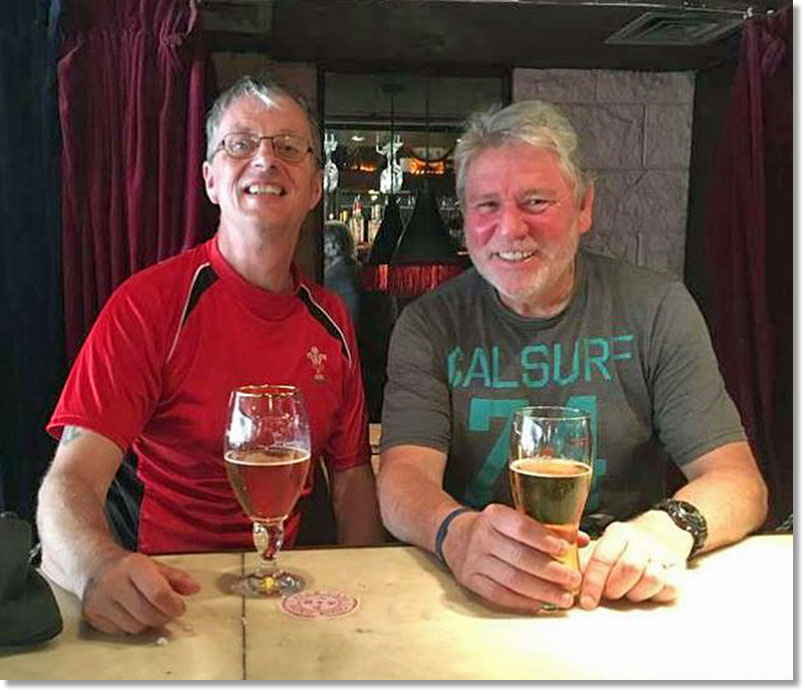
Taff Wood and Tony Geerah (RAF) taking a couple for the team in Hong Kong, May 2018.
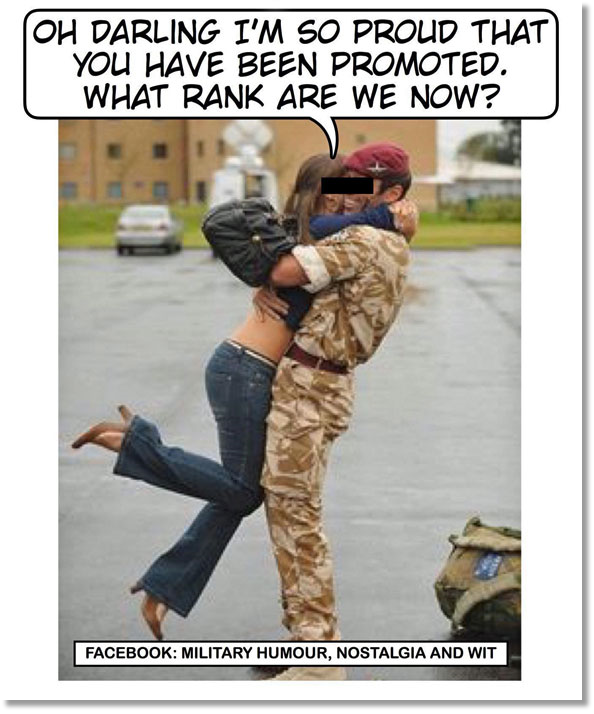
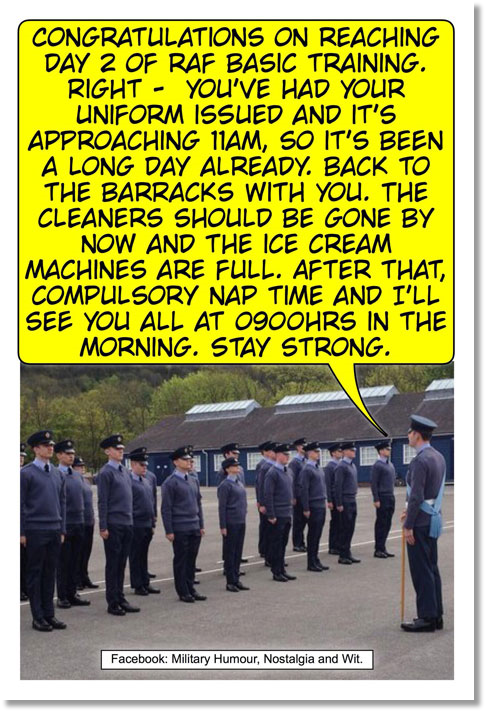
This Newsletter is Dedicated
to the Memories of:
John Priest (RCAF)
Group Captain Mike Davies (RAF)
Eileen Tanner, partner of Wayne Harker (RCAF)
Charlotte (Lottie) Devlin, wife of Robert (Rab) Devlin (RAF)
to the Memories of:
John Priest (RCAF)
Group Captain Mike Davies (RAF)
Eileen Tanner, partner of Wayne Harker (RCAF)
Charlotte (Lottie) Devlin, wife of Robert (Rab) Devlin (RAF)
Tony Gale
ukmamsoba@gmail.com
ukmamsoba@gmail.com
If you wish to send a donation to the OBA drop
me an e-mail and I'll tell how you can do it.
me an e-mail and I'll tell how you can do it.







